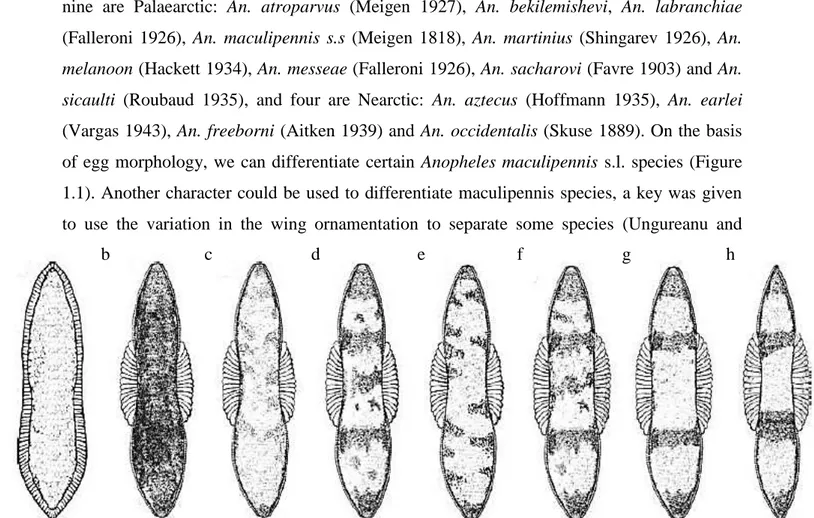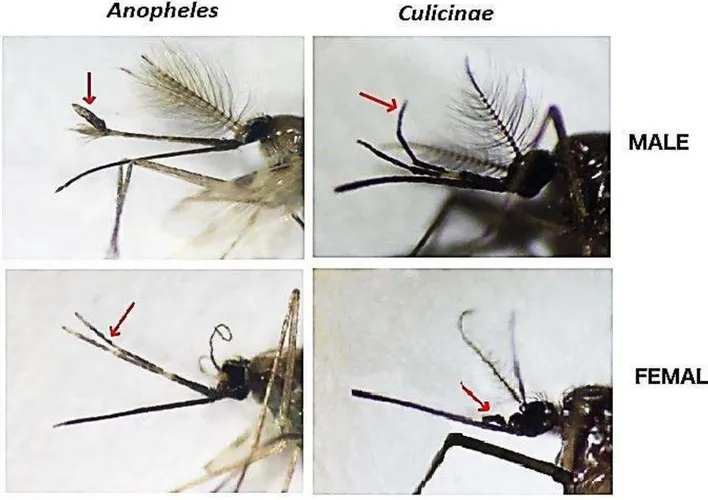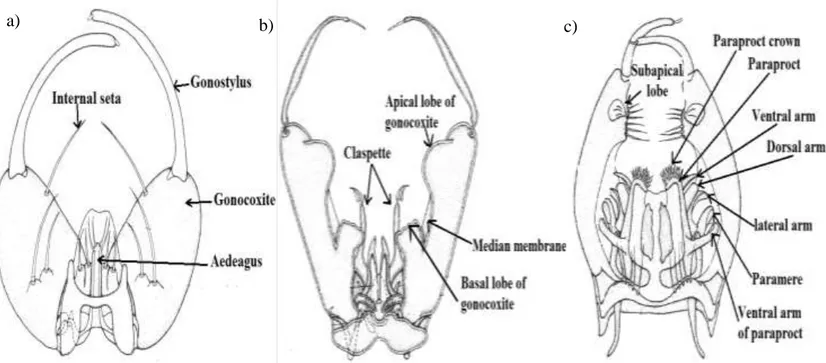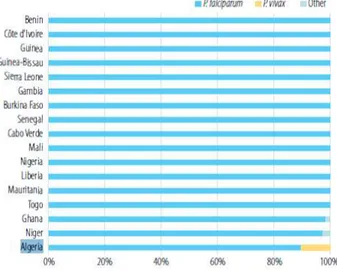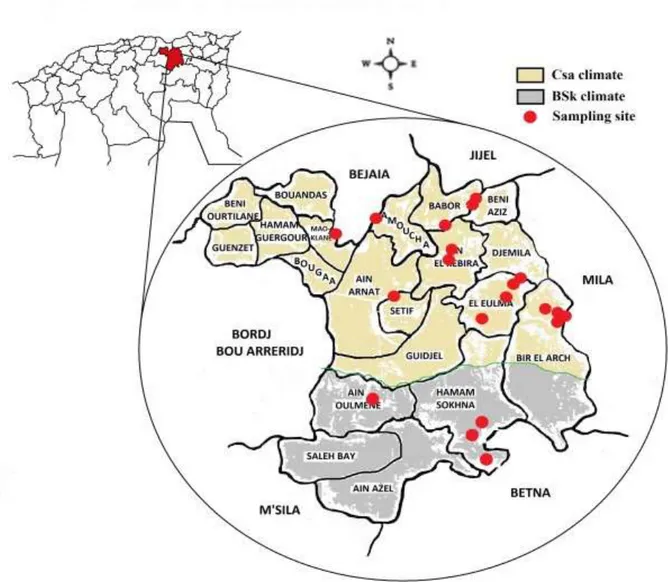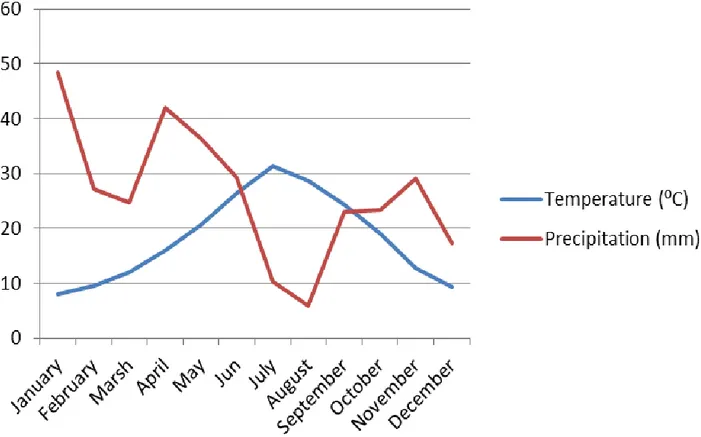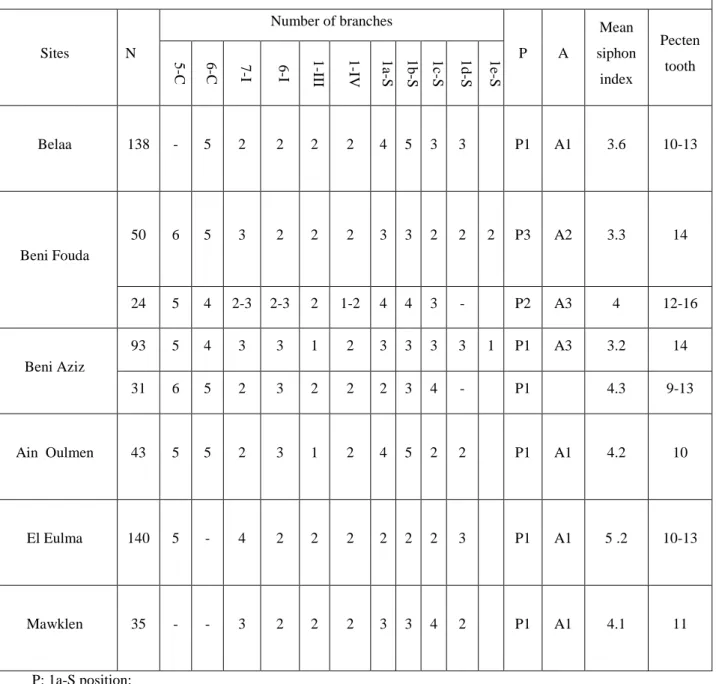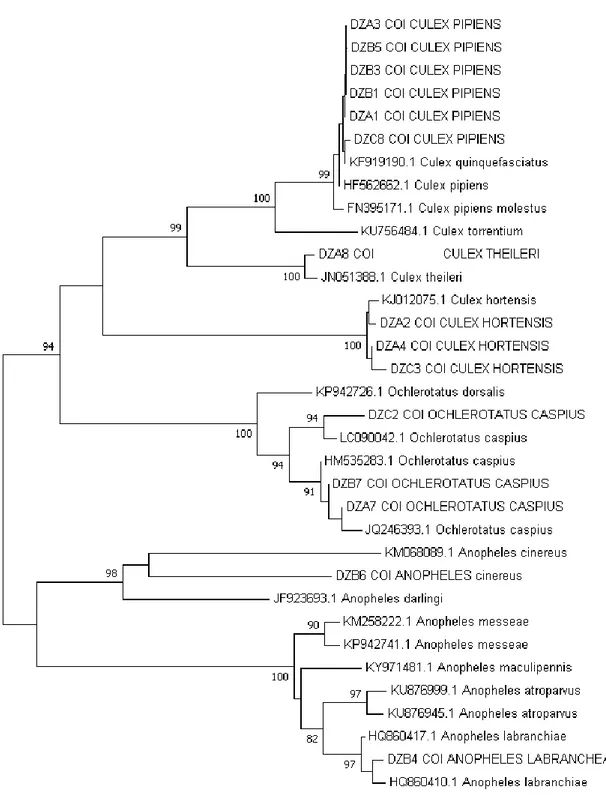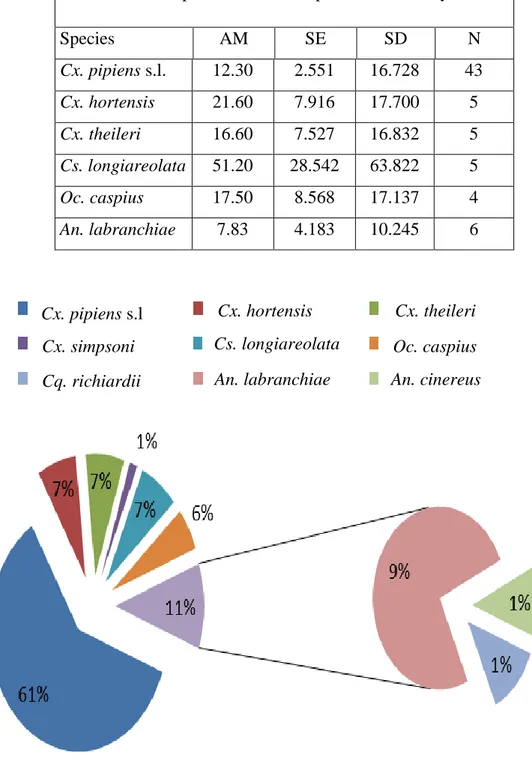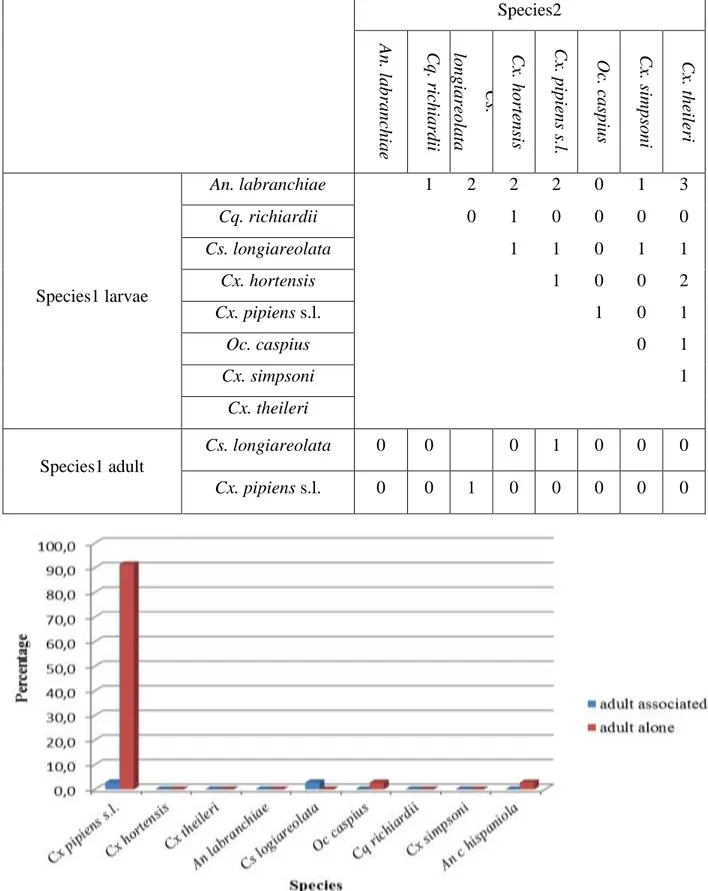DEPARTMENT OF BIOLOGY AND ANIMAL PHYSIOLOGY
Thesis
Presented by
NABTI Ismahane
For the fulfillment of the requirements for the degree of
Doctorat 3 CYCLE
Field: Biological sciences
Specialty: Animal ecology
topic
Inventory, Biology and Ecology of Culicidae (Diptera) of
Setif region and control tests using plant extracts
Presented publically 14/10/2020 Members of Jury
President: BENIA Farida Prof. UFA Setif 1
Supervisor: BOUNECHADA Mustapha Prof. UFA Setif 1
Examiners: AISSAOUI Linda MCA. UFA Setif 1
MERADSI Fouad MCA. Univ. Batna
LAATAMNA Abdelkrim MCA. Univ. Djelfa
Laboratory of Amelioration and Development of Vegetal and Animal production (LADPVA)
N°……….…………..…….……/SNV/2020
Université Ferhat Abbas Sétif 1 Faculté des Sciences de la
Nature et de la Vie
1
I
I DEDICATE THIS WORK TO MY FATHER, MY HUSBAND, MY
SISTERS, MY CHILDREN, MY GRANDMOTHER AND MY UNCLE. ALL
OF YOU WERE BESIDE ME AND SUPPORTED ME, SO THE WORDS
WILL NEVER BE ENOUGH TO THANK YOU. BUT THANK YOU FROM
ALL MY HEART.
IN MEMORY OF MY MOTHER AND MY GRANDFATHER, MAYBE YOU
LEFT US SINCE A LONG TIME, BUT YOU LIVE IN MY SOUL AND YOU
WERE WITH ME ALWAYS, I HOPE YOU ARE PROUD OF ME.
II
Thanks, to may supervisor Pr. Mustapha Bounechada that supported me and acts
when he should act to help me.
I sincerely thank the members of the jury for the honor they have given me for
agreeing to evaluate my thesis. Thus, I warmly thank the Presendent of this jury
Pr. Farida Benia. I would also like to thank Dr. Fouad Meradsi and Dr.
Abdelkrim Laatamna, as well as Dr. Linda Aissaoui for agreeing to be the
examiners of my thesis.
Thanks, to Dr, Mathieu Bruno (Medicine faculty, Institute of Parasitology and
Tropical Pathology (IPPTS)),
I have learn more from you, thank you for giving
me the opportunity to work in your laboratory and to share with me your
experience.
Thanks, to the institute of parasitology and tropical pathology, Strasbourg
(France), for having me and for funding my molecular analyses.
Thanks, to Pr. Saliha Dahamna, for here support, I will never forget what you
did for me, and the wonderful way you act with me.
Thanks, Mrs. Safia Zeghbib, you were always beside me, thank you for helping
me to publish my mosquito sequences in Genbank. May Allah help you and
guide you.
III ( تايضوعبلا ةرسأ دارفأ Culicidae ) ربتعا .عساو قاطن ىلع اهتسارد متي ةحنجلأا ةيئانث تارشح نع ةرابع يه يتلا تلاكشملا ببسب تاساردلا فلتخم زاجنلإ ةيروحم ةيجولويب ةدام وه ضوعبلا نأ تلااجملا فلتخم يف نوثحابلا وأ ناسنلإا ةحص ديعص ىلع ءاوس اهببست ةلئاع نم عاونأ يه لقانلا ضوعبلا .ناويحلا تايضوعبلا كراشت ام اًبلاغ يتلا لينلا سوريفو ءارفصلا ىمحلاو اينوغنوكيشلاو كنضلا ىمحو ايرلاملا لثم ةريطخلاو ةلتاقلا ضارملأا نم ديدعلا لقن يف ةقلعتملا ضارملأا يشفت رئازجلا تدهش ، ةيضاملا دوقعلا يف .خلإ ... اكيزو يبرغلا ، كلذ ىلإ ةفاضلإاب ؛ ضوعبلاب ( ءاضيبلا ةجعازلا ةيزاغلا عاونلأا رارقتسلا رضاحلا يف ضرعتت
Aedes albopictus (Skuse 1894)
) ، كلذ عمو . ةيناكسلا ةفاثكلاب ةقلعتملا تامولعملا يف صقن كانه ذإ فاك ريغ لاز ام رئازجلا يف ضوعبلل يجولويبلا عونتلا ةسارد نإف عيزوتلا طامنأو ، قايسلا اذه يف .ةيجولوفروملا ةيوهلا ديدحت ىلع طقف دمتعي عاونلأا درج نأ امك ضوعبلا تاعومجمل نم )ةيلاعلا ةيرئازجلا لوهسلا( فيطس ةقطنم يف ضوعبلل اًدرج انيرجأ 2016 ىلإ 2019 عاونأب ةمئاق ريفوت لجأ نم ، اهتفاثكو يجولويبلا اهعونت ليلحتو ةساردلا ةقطنم يف ضوعبلا رحبلا خانم( نيتفلتخم نيتيخانم نيتقطنم بسح اهعيزوتو لامشلا يف طسوتملا CSA يف يراق هبش خانم و بوهسلا قطانم BSk ديدحت مت. ةفلتخم ةيئاصحإ تارابتخا مادختساب ) ليلحت( يئيزجلا فيرعتلاو )صيخشتلا حيتافم( يجولوفروملا فيرعتلا نم لك مادختساب عاونلأا PCR-RFLP ثروملل COI Cytochrome c Oxidase subunit 1 gene )
. نم انكمت تلاقان كلذ يف امب ضوعبلا نم عاونأ ةعست ديدحت
ايرلاملا
Anopheles labranchiae (Falleroni 1926)
( 4.4 و )٪ (Theobald 1901) An c hispaniola ( 0.5 لسلست ريفوت مت امك. )٪ COI ةصنم ىلع ةرفوملا ضوعبلا نم عاونأ ةتسل Genbank ةيلسلستلا ماقرلاا بسح MK047302-MK047315 عونلا ناك ،هنم تانيع ذخأ مت يذلا ضوعبلا عومجم نم .
Culex pipiens (Linnaeus
(1758 ( بلاغلا وه 46.9 = ددرتلا( اًعويش رثكلأاو )٪ 61 ترهظأ امنيب )٪ Culiseta longiareolata (Macquart
(1838 ( ةفاثك ىلعأ 51.2 ± 63.7 .) نيب ةيباجيإو ةيلاع ةقلاع دوجو نع انفشك دقل ،كلذ ىلع ةولاع Cx. theileri (Theobald 1903) و (rs= 0.89, p> 0.001) An labranchiae مادختسا ةيناكمإ حرطي امم ، Cx. theileri يدوجو رشؤمك عونلل An labranchiae . دوجو ةلباقملا تلايلحتلاو ةيجوزلا ةنراقملا تدكأ ، كلذك نيب ريبك طابترا ةساردلا ةقطنم يف ةيخانملا قطانملاو ةفاثكلا / عاونلأا عيزوت (KW U = 51, p> 0.01) ىلع خانملا ريغت ريثأت تدكأو ، تاعومجم ةعومجم ءاضعأ رهظأ ، ىرخأ ةيحان نم .ضوعبلا Cx. pipiens مهب صاخلا يجلوفروملا نيوكتلا يف اًنيابت نيوكتلا ديدحتب انمق كلذل ، بكرمل يجولوفروملا Cx. pipiens عاونلأا زييمتو ةيلبقتسملا درجلا تايلمع ليهست لجأ نم ةيلحملا . تاديبملل ةلمتحم لئادب ةيساسلأا تويزلا ربتعت نيأ يساسأ رمأ ضوعبلا تاعومجم ىلع ةرطيسلا نإف ،ا ًريخأ مييقت ىلإ انيعس دقف كلذل .ةيعانطصلاا ةيرشحلا ا ةيساسلأا تويزلا ةردق قرش لامش نم اهعمج مت تاتابن نم ةجرختسمل ةضوعب تاقري ةفاثك ىلع ةرطيسلا ىلع رئازجلا Cs longiareolata ل ةلقانلا عاونلأا مهأ دحأ ربتعت يتلاو تايليفط مويدومزلابلا (plasmodium) ةساردلا ةقطنم يف ةفاثكو اراشتنا عاونلأا رثكأ نم ربتعت امك رويطلا دنع رابتخا مت . تويزلا عئاشلا يربلا رتعزلا نم ةجرختسملا ةيساسلأا Thymus vulgaris حيشلا و Artemisia herba-alba راعرعلاو Juniperus phoenicea لبجلا ليلكأ و Rosmarinus officinalis سوتيلاكلا و Eucalyptus globulus تاقريل عبارلاو ثلاثلا روطلا دض ، Cs longiareolata سل تاقريلا تضرعت ؛ تويزلا تازيكرت نم ةلسل ةدمل ةربتخملا ةيساسلأا 24 نيب ام ةافو يف تببست يتلا تازيكرتلا راركت مت .ةعاس 10 و ٪ 90 راركت مت امك تارم عبرأ ٪
IV 80 ةبسنب تايفولا لدعم نأ نيح يف ، نويلملا يف ءزج 100 يئاهنلا زيكرتلا دنع ناك تويزلا يقاب دنع ٪ 200 يف ءزج تلا ةلتاقلا تازيكرتلا تناك ، كلذ ىلع ةولاع .نويلملا ةبسنب تايفو يف تببست ي 50 و ٪ 90 ٪ (LC50,LC90) تم ةنياب تيز ناك ثيح عئاشلا يربلا رتعزلا ةءافك ةيساسلأا تويزلا رثكأ (LC50 = 25,64 ppm, LC90 = 50,53 ppm) هيلي راعرعلا تيز (LC50 = 59,83 ppm, LC90 = 137,68 ppm) لبجلا ليلكإ تيز مث (LC50 = 64,18 ppm, LC90 = 96,55 ppm) حيشلا تيز مث (LC50= 86,67 ppm, LC90 = 139,55 ppm) تيز ةريخلأا ةبترملا يفو سوتيلاكلا (LC50 = 95,83 ppm, LC90 = 168,25 ppm) . اهتانوكم وأ ةيساسلأا تويزلا مادختسا نإف ، يلاتلابو لثم ةيسيئرلا ةطشنلا α-pinene و 1،8 -cineole و Camphor تاقري يف مكحتلل ةئيبلل ةقيدص ةليسو نوكي دق يف مكحتلا و ةبقارملل لاماكتم اجمانرب رفوت اهلمجم يف اهب انمق يتلا ةساردلا نأ ريخلأا يف لوقن نأ عيطتسن كلذل .ضوعبلا فيطس ةقطنم يف ضوعبلا تاعومجم . :ةيحاتفملا تاملكلا ,فيطس ةقطنم ,ضوعبلا بلا ةسارد ,يجولويبلا عونتلا ةئي , تاقريلا ديبم طاشن .
V
The members of the family Culicidae, commonly known as mosquitoes, are Diptera insects widely studied. Researchers in various fields have considered mosquitoes as a focal biological material to study because they carry and spread disease to both humans and animals. Mosquito vectors are species of the family Culicidae often involved in the transmission of many deadly and dangerous diseases like malaria, dengue, chikungunya, yellow fever, West Nile virus, Zika…etc. In the last decades, Algeria has experienced outbreaks related to mosquitoes; additionally, it is exposed at the present to the installation of the invasive species Aedes albopictus (Skuse 1894). However, the mosquito biodiversity in Algeria is poorly studied, likewise, information about density and distribution patterns of mosquito populations is missed and the inventories were depended only on morphological identification. In this context, we performed a mosquito inventory in the Setif region (Algerian high plains) from 2016 to 2019, in order to provide the list of mosquito species in the study area and analyze their biodiversity, density and species distribution across two climate zones (Mediterranean Csa and steppe BSk Zones) using different statistical tests. The identification of species was done using a combination of morphological (diagnostic keys) and molecular (PCR-RFLP analysis of Cytochrome c Oxidase subunit 1 gene) approaches. The sampling yielded the identification of nine mosquito species including the malaria vectors
Anopheles labranchiae (Falleroni 1926) (4.4%) and An cinereus hispaniola (Theobald 1901)
(0.5%). The COI sequences of six species are provided (Accession numbers MK047302-MK047315). From the total sampled mosquitoes, Culex pipiens s.l (Linnaeus 1758) was the predominant (46.9 %) and the most frequent species (ƒ=61%) while Culiseta longiareolata (Macquart 1838) showed the highest density (51.2±63.7). Further, we have revealed a high and positive correlation between Cx. theileri (Theobald 1903) and An labranchiae (rs=0.89, p>0.001), which poses the possibility of using Cx. theileri as species indicator of An
labranchiae. Moreover, the pairwise comparison and Ordination Corresponding Analyses
ascertained the presence of a significant association between species distribution/density and climate zones in the study area (K-W U=51, p>0.01), and confirm the effect of the climate changes on the mosquito population. Furthermore, the members of Cx. pipiens s.l population showed a variation in their morphology, we demonstrated the unusual keys to facilitate the morphological identification in future inventories and to discriminate local species of Cx.
VI
plants collected from northeastern Algeria against Cs longiareolata larvae, a vector of
Plasmodium species in birds and one of the most abundant mosquito species at the studied
region. The essential oils extracted from: Thymus vulgaris, Artemisia herba-alba, Juniperus
phoenicea, Rosmarinus officinalis and Eucalyptus globulus, were tested against the 3rd and 4th instar Culiseta longiareolata larvae; the larvae were exposed to a series of concentrations of the tested essential oils for 24h. The concentrations that caused between 10% and 90% mortality was replicated four times, the entire test was repeated three times. The collected data was used to determine the LC50 and LC90 values. The tested oils revealed an efficient larvicidal activity, T. vulgaris showed 100% mortality at 80ppm final concentration, while the other tested oils showed 100% mortality at 200ppm. Furthermore, the lethal concentrations that caused 50% and 90% mortality (LC50 and LC90) were varying, T. vulgaris was the most efficient essential oil (LC50=25.64ppm, LC90=50.53ppm), followed by J. Phoenicea (LC50=59.83ppm, LC90=137.68ppm), R. officinalis (LC50= 64.18ppm, LC90= 96.55ppm), A.
herba-alba (86.67ppm LC50 and LC90=139.55ppm), then E. globulus (LC50=95.83ppm, LC90= 168.25ppm). Thus, The use of essential oils or their principal active components as α-pinene, 1,8-cineole and Camphor may serve as an eco-friendly method to control mosquito larvae. Consequently, the study provides a comprehensive program to control the mosquito population in the Setif region.
Keyword: Culicidae, Setif region, Biodiversity, Ecology, Larvicidal activity.
Author affiliation: Laboratory Research LADPVA, Department of Biology and Animal Physiology, Faculty of Nature and Life Sciences, Ferhat Abbas University, Setif 1, Setif, Algeria.
VII
Les membres de la famille des Culicidae, communément appelés moustiques, sont des insectes Diptères largement étudiés. Des chercheurs de divers domaines ont considéré les moustiques comme un matériel biologique essentiel à étudier en raison des problèmes qu’ils posent toujours, qui menacent à la fois la santé humaine et animale. Les espèces vecteurs de la famille des Culicidae sont souvent impliquées dans la transmission de nombreuses maladies mortelles et dangereuses telles que le paludisme, la dengue, le chikungunya, la fièvre jaune, le virus du Nil Occidental, Zika… etc. L'Algérie a connu des épidémies liées aux moustiques au cours des dernières décennies. De plus, il est actuellement exposé à l'installation de l'espèce invasive Aedes albopictus (Skuse 1894). Cependant, la biodiversité des moustiques en Algérie est peu étudiée. De même, les informations sur la densité et les schémas de répartition des populations de moustiques sont manquantes et les inventaires ne reposent que sur l'identification morphologique. Dans ce contexte, nous avons réalisé un inventaire des moustiques dans la région de Sétif (hautes plaines Algériennes) de 2016 à 2019, afin de fournir la liste des espèces de moustiques dans la zone d'étude et d'analyser leur biodiversité, leur densité et leur répartition entre espèces dans deux zones climatiques ( Csa dans le nord et BSk dans les région semi-aride) en utilisant différents tests statistiques. L'identification des espèces a été réalisée à l'aide d'une combinaison d'approches morphologiques (clés de diagnostic) et moléculaires (analyse PCR-RFLP du gène de la sous-unité 1 du cytochrome c oxydase COI). L'échantillonnage a permis d'identifier neuf espèces de moustiques, notamment les vecteurs du paludisme Anopheles labranchiae (Falleroni 1926) (4,4%) et An c hispaniola (Theobald 1901) (0,5%). les séquences de COI de six espèces sont fournies (numéros d'accès MK047302-MK047315). Parmi tous les moustiques échantillonnés, Cx. pipiens s.l (Linnaeus 1758) était l’espèce prédominante (46,9%) et la plus fréquente (ƒ = 61%), tandis que Culiseta
longiareolata (Macquart 1838) présentait la densité la plus élevée (51,2 ± 63,7). De plus, nous
avons révélé une forte corrélation positive entre Cx. theileri (Theobald 1903) et An
labranchiae (rs = 0,89, p> 0,001), ce qui laisse entrevoir la possibilité d’utiliser Cx. theileri
comme indicateur d’An labranchiae. Après, la comparaison par paires et les analyses d'ordination correspondantes ont permis d'établir la présence d'une association significative entre la répartition / densité des espèces et les zones climatiques dans la zone d'étude (KW U = 51, p> 0,01), et de confirmer l'effet des changements climatiques sur les populations de moustiques. En outre, la morphologie des membres de la population de Cx. pipiens s.l variait,
VIII
complexe. Enfin, le control de moustique est une chose indispensable et l'utilisation des huiles essentielles dans la lutte contre les moustiques est considérée comme une alternative potentielle aux insecticides de synthèse. Nous avons donc cherché à évaluer l’activité larvicide des huiles essentielles extraites de cinq plantes médicinales recueillies dans le nord-est de l’Algérie contre les larves de Culiseta longiareolata, l’espèce vecteur du Plasmodium chez les oiseaux et l’une des espèces de moustiques les plus abondantes dans la région étudiée. Les huiles essentielles extraites de: Thymus vulgaris, Artemisia herba-alba, Juniperus
phoenicea, Rosmarinus officinalis et Eucalyptus globulus ont été testées contre les larves de
3ème et 4ème stades de Culiseta longiareolata; les larves ont été exposées à une série de concentrations des huiles essentielles testées pendant 24h. Les concentrations qui ont causé une mortalité comprise entre 10% et 90% ont été répliquées quatre fois, l’essai entier a été répété trois fois. Les données collectées ont été utilisées pour déterminer les valeurs de la LC50 et de la LC90. Les huiles testées ont révélé une activité larvicide efficace, T. vulgaris a présenté une mortalité de 100% à une concentration finale de 80 ppm, tandis que les autres huiles testées ont présenté une mortalité de 100% à 200 ppm. En outre, les concentrations létales ont causées des valeur de mortalité à 50% et 90% (LC50 et LC90) variée, T. vulgaris étant l'huile essentielle la plus efficace (LC50 = 25,64 ppm, LC90 = 50,53 ppm), suivie de J.
Phoenicea (LC50 = 59,83 ppm, LC90 = 137,68 ppm), R. officinalis (LC50 = 64,18 ppm, LC90 = 96,55 ppm), A. herba-alba (LC50= 86,67 ppm, LC90 = 139,55 ppm), puis E. globulus (LC50 = 95,83 ppm, LC90 = 168,25 ppm). Ainsi, l'utilisation d'huiles essentielles ou de leurs principaux composants actifs tels que l'α-pinène, le 1,8-cinéole et le camphre peut servir de méthode écologique pour lutter contre les larves de moustiques. Par conséquent, la présente étude à fournit un programme complet pour contrôler la population de moustiques dans la région de Sétif.
IX A. Ae: Aedes An: Anopheles Arithmetic mean AM C.
CCA: canonical corresponding analysis Cs: Culiseta
Csa : warm temperate climate with warm and dry summer Cx: Culex
B.
BSk : semi-arid; cold and dry climate D.
DENV: Dengue fever
DDT: Dichloro-diphenyl-trichloroethane E.
EO: essential oils H.
HCH: γ-hexachlorocyclohexane L.
LC50: concentrations that cause 50% of death LC90: concentrations that cause 90% of death O.
Oc: Ochlerotatus
OHF: Omsk haemorrhagic fever virus S.
SE: Standard Error W.
X Z.
XI
PUBLICATION AND COMMUNICATION
PUBLICATION
Nabti I. & Bounechada M., 2019. Larvicidal Activities of Essential Oils Extracted from Five Algerian Medicinal Plants against Culiseta longiareolata Macquart. Larvae (Diptera: Culicidae). European Journal of Biology. 78(2).
Nabti I. & Bounechada M., 2019. Mosquito biodiversity in Setif region (Algerian High Plains), density and species distribution across two climates zones. Entomologie faunistique –
Faunistic Entomology 2019 72, 161-173
COMMUNICATION
Mosquito control using Juniperus phonecea L. essential oil as an alternative of chemical insecticides. Nabti I. & Bounechada M. International symposium entitled “environment & Sustainable Development”, Relizane, (Algeria) 10-11 February 2020
Habitat preferences of mosquito species in the Algerian high plains (Setif region). Nabti I. & Bounechada M. National symposium entitled “L’Apport des Biotechnologies sur la protection de l’environnement”, M’sila, (Algeria) 15-16 December 2019.
Variation écologique et morpho-métriques observées sur les larves de Culex pipiens s.l dans les hautes plaines Algeriennes. Nabti I. & Bounechada M. National symposium entitled “l’environnement et le développement durable”, Mascara, (Algeria) 22-23 January 2020.
Cooccurrence des larves de moustique et la possibilité d’utiliser le niveau de corrélation pour l’utilisation d’espèce indicatrices dans la détection des espèces vectrices. Nabti I. & Bounechada M. National symposium entitled “1ere journée nationale d’entomologie et de parasitologie”, Mascara, (Algeria) 11 March 2020.
XII
Dedication ... I Acknowledgement ... II Abstract ... V Figure list ... XVI Photo list ... XIX Table list ... XXI
General intorduction ... 1
Chapter 1: bibliographic review ... 4
1 Systematic ... 4 1.1 Culicidae sub-families ... 4 1.1.1 Culicinae ... 4 1.1.2 Anophelinae ... 5 1.2 Complex species ... 5 1.2.1 Anophelinae complex ... 5
1.2.1.1 Anopheles maculipennis s.l complex ... 6
1.2.1.2 Anopheles cinereus s.l complex ... 7
1.2.2 Culicinae complexes ... 7
1.2.2.1 Ochlerotatus caspius ... 7
1.2.2.2 Culex pipiens s.l complex ... 8
1.3 Mosquitoes in north africa: review ... 8
2 Mosquito biology and ecology ... 9
2.1 Mosquito biology ... 9
2.1.1 Oviposition ... 9
2.1.2 Larvae ... 10
2.1.3 Pupae ... 12
2.1.4 Adult ... 13
2.2 Characterization of mosquito species ... 15
2.2.1 Identification based on pictorial keys ... 15
2.2.1.1 Larvae morphology ... 15
2.2.1.2 Adult morphology ... 15
XIII
2.2.2 Molecular identification ... 20
2.3 Mosquito ecology ... 23
2.3.1 Biotic factors ... 23
2.3.1.1 Breeding sites selection ... 23
2.3.1.2 Development and survival of larvae ... 24
2.3.1.3 Interactions with co-occurring organisms ... 25
2.3.2 Abiotic factors ... 25
2.3.2.1 Urbanization ... 25
2.3.2.2 Climate change ... 26
3 Medical importance ... 26
3.1 Malaria ... 26
3.2 West nile virus (wnv) ... 27
3.3 Dengue fever virus (denv)... 28
3.4 Yellow fever virus (yfv) ... 29
3.5 Zika virus (zikv) ... 29
4 Mosquito control ... 29 4.1 Chemical control ... 30 4.2 Biological control ... 30 4.2.1 Plant-born insecticides ... 30 4.2.2 Co-occurring predators ... 31 4.2.3 Microbial-control ... 32
4.2.4 Sterile insect technique (sit) ... 32
Chapter 2: Mosquito biodiversity in setif region ... 34
1 Material and methods ... 34
1.1 Study Area ... 34
1.1.1 Overview ... 34
1.1.2 Water surfaces ... 35
1.1.3 Temperature and precipitation during sampling period ... 35
1.1.4 Sampling sites ... 35
1.2 Sampling ... 43
1.2.1 Larvae sampling and preparation for observation ... 43
XIV
2.4.1 Pcr test ... 46
2.4.2 Phylogenetic analyses ... 47
1.5 Ecological data analyses ... 47
2 Results ... 49
2.1 Species identification ... 49
2.1.1 Morphological identification ... 50
2.1.1.1 Coquillettidia richiardii larvae ... 50
2.1.1.2 Culiseta longiareolata... 51
2.1.1.2.1 Culiseta longiareolata larvae ... 51
2.1.1.2.2 Culiseta longiareolata adult ... 52
2.1.1.3 Ochlerotatus caspius ... 53
2.1.1.3.1 Ochlerotatus caspius larvae ... 53
2.1.1.3.2 Ochlerotatus caspius adult ... 54
2.1.1.4 Culex theileri ... 55
2.1.1.4.1 Culex theileri larvae ... 55
2.1.1.4.2 Culex theileri adult ... 57
2.1.1.5 Culex simpsoni ... 58
2.1.1.5.1 Culex simpsoni larvae ... 58
2.1.1.5.2 Culex simpsoni adult ... 59
2.1.1.6 Culex hortensis larvae ... 59
2.1.1.7 Culex pipiens s.l. ... 60
2.1.1.7.1 Culex pipiens s.l. larvae ... 60
2.1.1.7.2 Culex pipiens adult ... 61
2.1.1.8 Anopheles labranchiae ... 62
2.1.1.8.1 Anopheles labranchiae larvae ... 62
2.1.1.8.2 Anopheles labranchiae adult ... 63
2.1.2 Morphological variation noted on mosquito larvae ... 65
2.1.3 Molecular identification ... 70
2.2 Sampling data ... 73
2.3 Mosquito descriptive parameters ... 76
2.3.1 Total descriptive parameters ... 76
XV
2.4.2 Larvae co-occurrence in breeding sites ... 80
2.5 Characterization of larvae habitat preferences... 81
2.5.1 Frequency and crosstabs ... 81
2.5.2 Density according to breeding sites parameters ... 83
2.6 Distribution patterns ... 83
2.6.1 Mosquito distribution across months ... 83
2.6.2 Mosquito distribution across climate zone ... 85
2.6.2.1 Comparing densities ... 85
2.6.2.2 Comparing species distribution ... 87
3 Discussion ... 89
3.1 Mosquito biodiversity in setif region ... 89
3.2 Breeding sites preferences ... 95
3.3 Distribution patterns ... 97
Chapter 3: Larvicidal activity test ... 99
1 Material and methods ... 99
1.1 Essential oils ... 99 1.1.1 Thymus vulgaris ... 99 1.1.2 Artemisia herba-alba ... 99 1.1.3 Juniperus phoenicea ... 101 1.1.4 Rosmarinus officinalis ... 101 1.1.5 Eucalyptus globulus ... 105 1.2 Mosquito collection ... 106 1.3 Larvicidal bioassays ... 106 1.4 Statistical analyses ... 108 2 Results: ... 108 3 Discussion: ... 117 General conclusion ... 120 Perspectives ... 123 References ... 124 Annex ... 149
XVI
Figure 1. 1. Eggs of Maculipennis complex: a. An. sacharovi, b. An. melanoon, c. An.
atroparvus, d. An. subalpinus, e. An. labranchiae, f. An. messea, g. An. maculipennis s.s,
h. An. beklemishevi (becker et al., 2003) ... 6
Figure 1. 2. Mosquito eggs: a) Anopheles, b) Aedes, c) Culex and Culiseta (mehlhorn, 2001) modified. ... 9
Figure 1. 3. Respiratory segment a) Anopheles: spiracle, b) Culicinae: siphon (ucr, 2019) modified. ... 11
Figure 1. 4. Mosquito larvae resting, a) Anopheles, b) Culicinae (mehlhorn, 2001) modified. ... 12
Figure 1. 5. Coquillettidia and Mansonia s submerge to aquatic plants (icpmr, 2019). ... 12
Figure 1. 6. Mosquito pupae: a) Culex, b) Anopheles (becker et al., 2003) modified. ... 13
Figure 1. 7. Mosquito adult resting: a) Anopheles, b) Culicinae. (mehlhorn, 2001) modified. ... 14
Figure 1. 8. Mosquito larvae morphology with setae position and numbers (becker et al., 2003). ... 17
Figure 1. 9. General morphology of adult mosquitoes. ... 18
Figure 1. 10. Head of male and female Anopheles and Culicinae adults ... 18
Figure 1. 11. Thorax setation in lateral view (becker et al., 2003) ... 19
Figure 1. 12. General morphology of mosquito adult abdomen (gunay et al., 2018) modified. .... 19
Figure 1. 13. Wing venation : a) Culicinae, b) Anophelinae (becker et al., 2003) modified. ... 19
Figure 1. 14. Pictorial keys for the identification of adult mosquitoes (Culicidae) genera (photos obtained from gunay et al. (2018)). ... 21
Figure 1. 15. Pictorial keys for the identification of adult mosquitoes (Culicidae) genera (photos obtained from gunay et al. (2018)). ... 22
Figure 1. 16. Mosquito male hypopygium: a) Anopheles genus, b) Aedes/Ochlerotatus genus, c) Culex genus ((becker et al., 2003) modified). ... 23
Figure 1. 17. Percentage of cases due to plasmodium falciparum and p. vivax, 2009-2013 (who-algeria, 2014 ). ... 27
Figure 1. 18. Percentage of population at risk of malaria with access to an insecticide-treated mosquito net (itn) and percentage protected with indoor residual spraying (irs), 2013 (WHO-algeria, 2014 ). ... 27
Figure 2. 1. The geographical localization of Setif region and the distribution of the sampling sites (n=20) in two types of climate zones: Csa (mediterranean climate) and BSK (steppe climate).. ... 34
Figure 2. 2. Mean temperature in ⁰c and precipitation per month in mm in setif region during the field inspection period 2016-2019 (onm, office national de la météorologique. 2019) .... 36
Figure 2. 3. Site 4 (personal photo). ... 38
Figure 2. 4. Site 5 (personal photo). ... 38
Figure 2. 5. Site 3 (personal photo). ... 38
Figure 2. 6. Site 1 (personal photo). ... 39
Figure 2. 7. Site 7 (personal photo). ... 39
XVII
Figure 2. 11. Site 11 (personal photo). ... 41
Figure 2. 12. A) sites 17, b) site 16, c) site 15 (personal photo). ... 42
Figure 2. 13. A) site 20, b) site 19, c) site 18 (personal photo). ... 42
Figure 3.1. Phylogenetic tree represents the evolutionary relationship among the sampled species and sequences from genbank. ... 71
Figure 3.2. Frequency percentages of mosquito species sampled from setif region from 2016 to 2019. ... 77
Figure 3.3. Frequency of adult mosquitoes sampled from setif region 2016-2019 to occur alone or associated. ... 79
Figure 3.4. Frequency of mosquito larvae sampled from setif region 2016-2019 to occur alone or associated. ... 80
Figure 3.5. Corrgram estimated of the level of correlation between mosquito larvae found co-occurred in breeding sites. ... 81
Figure 3.6. Frequency percentages of the general parameters of the sampling sites, with crosstabs frequencies. ... 82
Figure 3.7. Mosquito density fluctuation during the year shows three peaks in May, August, and December. ... 84
Figure 3.8. Mosquito species fluctuation during the year according to the data sampling from Setif region 2016-2019 ... 84
Figure 3.9. Mosquito descreptive parameters across climate zone BSK and Csa in setif region. . 85
Figure 3.10. Mosquito descreptive parameters in Csa zone in setif region. ... 86
Figure 3.11. Mosquito descreptive parameters in BSK zone in setif region. ... 86
Figure 3.12. Mosquito species frequency in Bsk climate zone ... 87
Figure 3.13. Mosquito species frequency in Csa climate zone ... 87
Figure 3.14. CCA Analysis show three clusters, two clusters related to climate zone Csa And BSK marked in circles, and a third cluster not related in any of the climate zones (Culex pipiens, Cx. theileri, Cx. hortensis). ... 88
Figure 3.15. Mosquito species distribution card of setif region. ... 89
Figure 3. 16 Culiseta longiareolata pools (personal photos). ... 106
Figure 3. 17. Probit transformed responses with equation regression and coefficient of determination R2 for T. vulgaris essential oil tested on 3rd and 4th instars larvae of Culiseta Longiareolata for 24 H. ... 115
Figure 3. 18. Probit Transformed Responses with equation regression and coefficient of determination R2 For J. Phoenicea tested on 3rd and 4th instars larvae of Culiseta longiareolata for 24 H. ... 115
Figure 3. 19. Probit Transformed Responses with equation regression and coefficient of determination R2 for A. herba-Alba essential oil tested on 3rd and 4th instars larvae of Culiseta longiareolata.For 24 H ... 116
Figure 3. 20. Probit Transformed Responses with equation regression and coefficient of determination R2 For R. officinalis essential oil tested on 3rd and 4th instars larvae of Culiseta longiareolata for 24 H. ... 116
XVIII
XIX
Photo 2.1. Mosquito sampling and separation for easy counting (personal photos). ... 43
Photo 2.2. Larvae preparation for permanent preservation (personal photo). ... 44
Photo 2.3. Handmade cdc traps (personal photo). ... 44
Photo 2.4. Aspiration of emerged adults using mouth aspirator (personal photo). ... 45
Photo 2.5. Females pinned for morphological observation (personal photo). ... 45
Photo 2.6. Larvae observation using microscope lcd (personal photo). ... 46
Photo 2.7. Adult female observation using binocular microscope loupe (personal photo)... 46
Photo 3.1. Coquillettidia richiardii larvae (personal photo). ... 50
Photo 3.2. Coquillettidia richiardii: short conical respiratory tube and integument of the saddle with spicules grouped by 2 (personal photo magnification 10x). ... 50
Photo 3.3. Siphon of Culiseta longiareolata (personal photo magnification 10x). ... 51
Photo 3.4. Culiseta longiareolata larvae: smooth antenna and cephalic setae 1-a hardly noticeable (personal photo magnification 10x). ... 51
Photo 3.5. Culiseta longiareolata: a) pinned adult, b) mouthpart: maxillary palpus clearly shorter than proboscis (personal photo). ... 52
Photo 3.6. Culiseta longiareolata: a) scutum ornamentation with pale continuous bands; b) tergite: with creamy and dark scales (personal photo magnification 10x). ... 52
Photo 3.7. Siphon of Ochlerotatus caspius (personal photo magnification 10x). ... 53
Photo 3.8. Antenna of Ochlerotatus caspius larvae: number of branches and position of seta 1-a (personal photo magnification 10x). ... 53
Photo 3.9. Ochlerotatus caspius: tergite covered with pale scale scales (personal photos magnification 10x). ... 54
Photo 3.10. Ochlerotatus caspius: dark and pale scales on the wing (personal photos magnification 10x). ... 54
Photo 3.11. Ochlerotatus caspius: a) torax, b) leg (personal photos magnification 10x). ... 55
Photo 3.12. Comb scales with median spine (personal photo magnification 40x). ... 56
Photo 3.13. Siphon of Culex theileri larvae: ventral and lateral tuffs, 1a-s beyond the pecten, seta 2-s is short (personal photo magnification 10x). ... 56
Photo 3.14. Culex theileri: prespiracular and postspiracular setae absent (personal photo magnification 10x). ... 57
Photo 3.15. Culex theileri larvae: the tergite with a basal pale band extending backwards in a median triangle (personal photo). ... 57
Photo 3.16. Culex theileri: male hypopygium (personal photo magnification 10x). ... 58
Photo 3.17. Culex simpsoni: insertion and number of branches of seta 1a-s, and shape of 2-s (personal photo magnification 4x). ... 58
Photo 3.18. Culex simpsoni proboscis and maxillary palpus (personal photo magnification 10x). ... 59
Photo 3.19. Culex hortensis larvae: siphon with ventral and lateral tufts and seta 2-s long and hooked (personal photos magnification 10x). ... 60
XX
Photo 3.21. Culex pipiens larvae: a) siphon with straight sides, b) saddle seta 1-x (personal photo magnification 10x).. ... 61 Photo 3.22. Culex pipiens: a) wings with scale in the base, b) leg iii, tarsomere 1 and 5
(personal photos). ... 62 Photo 3.23. Culex pipiens: a) thorax, b) tergite with base pale band (personal photos
magnification 10x). ... 62 Photo 3.24. Cephalic setae of Anopheles labranchiae larvae: a) seta 8-c six branched, b) seta
2-c aciculate at the apex (personal photos magnification 10x, 4x). ... 63 Photo 3.25. Anopheles labranchiae female: maxillary palpus nearly equal to proboscis
(personal photos). ... 64 Photo 3.26. Anopheles labranchiae female: dark wings with black spots (personal photo). ... 64 Photo 3.27. Anopheles labranchiae female: scutum with one median band (personal photo). ... 64 Photo 3.28. Anopheles labranchiae hypopygium: a) gonostylus about as long as gonocoxite b)
two parabasal setae (personal photos magnification 10x). ... 65 Photo 3.29. Variation in the position of siphonal seta 1a-s: a) 1a-s above and far from the most
distal pecten tooth b) la-S above and very near to the most distal pecten tooth, c) 1a-S next to the most distal pecten tooth in the both sides, d) 1a-S next to the most distal pecten tooth in the left side and 1a-S above the most pecten tooth in the right side (personal photos magnification 10x, 4x). ... 68 Photo 3.30. Shared characters in the sampled larvae: a) dorsal anal papillae equal to the saddle
and ventral anal papillae smaller than saddle, b) mantle plate with 11 teeth on the left side of the median apical tooth and 10 on the right side (personal photos magnification 4x). ... 68 Photo 3.31. Shape of siphon and arrangement of siphonal sitae in larvae collected from beni
fouda : a) wide siphon with sitae 4 arranged and 1c-S out of line, b) narrow siphon with setae 5 arranged and 1d-S out of line in the left side of the siphon and 1c-s out of line in the right side (personal photos magnification 10x). ... 69 Photo 3.32. Arrangement of siphon setae in larvae with 1a-S inserted above the last pecten
tooth : a) 1-S 5 arranged and 1c-S is out of line, b) 1-S 5 arranged and 1d-S is out of line, c) 1-S 4 arranged and 1d-S is out of line, d) 1-S 4 arranged and 1c-S is out of line (personal photos magnification 10x). ... 69
XXI
Table 2.1. Sites of sampling, with altitude and geographic coordinates. ... 37 Table 3.1. Morphological characteristics of Culex pipiens populations sampled from Setif
region ... 67 Table 3.2. The blast results of the sampled species sequences with genbank accessions. ... 72 Table 3.3. Sampling data of mosquitoes in Setif, northeastern Algeria, from 2016 to 2019. ... 73 Table 3.4. Descriptive statistics of mosquitoes in the study area. ... 76 Table 3.5. Descriptive statistics of larvae and adults in the study area. ... 76 Table 3.6. Descriptive statistics of species in the study area. ... 77 Table 3.7. Descriptive statistics of species in the breeding sites. ... 78 Table 3.8. Species associations observed during mosquito sampling in setif region 2016-2019. . 79 Table 3.9. Descriptive statistics of species in the study area. ... 82 Table 2.1. Chemical composition of the essential oils Thymus vulgaris (Algeria) (Giordani et
al., 2008). ... 100
Table 2.2. Chemical Composition Of Artemisia herba-alba essential oil harvested from m’sila, algeria (Dob and Benabdelkader, 2006). ... 102 Table 2.3. Chemical composition of Juniperus phoenicea essential oil (Algeria). (Mazari et
al., 2010) ... 103
Table 2.4. Composition of Rosmarinus officinalis essential oil (Algeria). (Djeddi et al., 2007). 104 Table 2.5. Chemical composition of Eucalyptus globulus essential oil from Algeria (Samir et
al., 2001) ... 105
Table 2.6. Dilution of essential oil volumes to obtain initial concentrations. ... 107 Table 2.7. Aliquots added to obtain final concentrations in ppm... 107 Table 3.1. Mortality data obtained through testing the larvicidal activity of T. vulgaris on
Culiseta longiareolata larvae ... 109
Table 3.2. Mortality data obtained through testing the larvicidal activity of J. phoenicia on
Culiseta longiareolata larvae. ... 110
Table 3.3. mortality data obtained through testing the larvicidal activity of A. herba-alba on
Culiseta longiareolata larvae. ... 111
Table 3.4. Mortality data obtained through testing the larvicidal activity of R. officinalis on
Culiseta longiareolata larvae. ... 112
Table 3.5. Mortality data through by testing the larvicidal activity of E. globulus on Culiseta
longiareolata larvae. ... 113
Table 3.6. Mortality percentages of Culiseta longiareolata larvae caused by the tested essential oils at different concentrations, with the arthemitric mean (AM) and standard error (SE). ... 114 Table 3.7. The LC50 and LC90 values of essential oils extracted from T. vulgaris, A.
herba-alba, J. phoenicea, R. officinalis And E. globulus against 3rd and 4th instars larvae of Culiseta longiareolata after 24 hours exposure period. ... 114
Table 4.1. Principal component percentages of T. vulgaris, A. herba-alba, J. phoenicea, R.
1
GENERAL INTRODUCTION
Insects are beneficial and important living organisms that participate in the different levels of food chains whether as prey, predators, scavengers or decomposers. However, many insect families include vector species capable to transmit viruses, bacteria and parasites to both humans and animals, threatening the public health. The family Culicidae (mosquitoes) is one of the most important and largest insect families, and it also includes a group of the most competent vector species.
Mosquitoes exist everywhere in the globe except Antarctica; they are characterized by high adaptability to different types of climate. Its life cycle pass through two important phases: aquatic and aerial. The female mosquitoes lay their eggs on the water surface, and then the eggs hatch and live in the water as larvae and pupae until they reach the adult stage; after, the adult mosquitoes leave the surface of the water and start their lives very close to the human environment. Mosquitoes can breed very quickly and in high numbers, and constitute a major inconvenience to humans. Unfortunately, mosquitoes inconveniences do not depend exclusively on their annoying bites, but they transmit diseases that caused millions of deaths (Water and Organization, 2004).
The vector ability of some mosquito species made them an important biological material for conducting various types of research due to the urgent need to control them and the public health problems that they cause. The information provided by these studies can be linked and used to control mosquito populations, and the information provided on the environmental characteristics of mosquitoes may be the most important. The biological and ecological characteristics of mosquito populations provide information about mosquito breeding sites, their density and their distribution by species and region. It also analyzes the environmental and climatic factors that can affect the density and distribution of mosquitoes by geographical dimensions and climatic zones. Mosquito biodiversity is undergoing continuing changes explained by the modification in population richness noted by inventorying studies (Benedict
et al., 2007; Berti et al., 2015; Linares et al., 2016). Further, mosquito species live in a
particular area act as a population that interacts beyond a defined dynamic affected by competition and climatic conditions (Kingsolver, 1989; Alto et al., 2005; de Oliveira et al.,
2
2017). Therefore, the study of mosquito biodiversity must consider co-occurrence, density and distribution patterns.
However, good ecological study has to start with a good inventory. The Identification is of huge importance in the medical entomology, Jourdain et al. (2018) gave a set of blind samples consisting of adult mosquitoes and larvae to participant laboratories for genus and species identification. This evaluation showed that all identifications were exclusively morphological. 81% of identifications were correct at the genus level, 64% at the species level. Thus, the morphological identification of mosquitoes, when used alone, may lead to false lists of species. Recently, DNA-based identification was adopted to support mosquito inventories using the sequence divergence at cytochrome c oxidase subunit 1(COI) to discriminate closely related mosquito species (Laboudi et al., 2011; Engdahl et al., 2014; Afizah et al., 2019). Consequently, the integrative taxonomy approach represented in the combination of morphological and molecular identification results more assured mosquito species lists.
The accurate inventory lists and data collected from the inspection filed will definitely provide sufficient information to implement a control program to monitor mosquito populations; nevertheless, we will finally need to use insecticides to reduce mosquito density and control their numbers. However, chemical pesticides routinely used can pose an environmental risk vis-a-vis other organisms. So much research has been done to find environmentally friendly alternatives that enable us to monitor mosquitoes without causing collateral damage. For instance, the enhancement of behavior-based control tools and the development of repellent and toxic products based on botanic components can target different mosquito life stages (Benelli, 2015; Benelli et al., 2016). Essential oils (EOs) extracted from different parts of plants were frequently tested for their mosquitocidal activity (Pavela, 2015); these primary botanic materials present various biological activities, they can act as insecticides where they can affect either the oviposition, survival, larval duration, pupation and insect emergence (Bakkali et al., 2008; Bessah and Benyoussef, 2015). However, the larvae stage appears to be more appropriate to control mosquito populations because of the high reproduction rates and larvae food mechanisms that allow a high number of mosquito individuals to be targeted simultaneously. Therefore, the assessment of the larvicidal efficacy of various plant derivatives was the main objective of many research papers (Markouk et al., 2000; Park et al., 2002; Elimam et al., 2009; Ghosh et al., 2012).
3 In this study, we fixed several objectives:
- The first part will demonstrate a general review of the biology and the ecology of mosquitoes plus to the most important eco-friendly methods evaluated to control mosquito populations.
- In the second part, we will investigate mosquito populations in the Setif region using the most accurate method, the integrative method, that confound both the morphological identification that based on pictorial keys for basic information, and the molecular method represented in the DNA-based identification of the COI barcode to obtain an ascertained species list.
- Simultaneously, we will analyze the collected ecological data using the most accurate bio-statistical software in order to extract the maximum information about mosquito density, fluctuation, distribution, and breeding site preferences. The results will lead to designate cartography of the distribution of mosquito populations in the Setif region and highlight its distribution patterns.
- Finally, we will test in the last part, the larvicidal activity of the essential oils extracted from five aromatic medicinal plants on Culiseta longiareolata (Macquart 1838) larvae as an alternative natural insecticide to control mosquitoes.
4
CHAPTER 1 BIBLIOGRAPHIC REVIEW
1 Systematic
After discovering the involvement of mosquitoes in transmitting microfilaria and protozoa, Chamberlain J the secretary of State for the Colonies of Britain appointed a committee to collect mosquitoes from British colonies and send them to British museum that subsequently appointed Theobald FV to prepare the description of mosquitoes of the world; the published book “a monograph of the Culicidae of the world” (Theobald, 1901) illustrated in its five editions first descriptions of many mosquito species. In the midst of continuous new records, the classification of Culicidae has undergone several changes. According to Becker et
al. (2003), Edwards (1932) established three subfamilies in the family Culicidae:
Anophelinae, Culicinae, and Toxorhynchitinae. A more recent study conducted by Harbach and Kitching (1998) confirmed the position of the Anophelinae and Culicinae as a subfamily within the family Culicidae; whereas, they considered the Toxorhynchitinae as a tribal rank within the Culicinae sub-family. Classifying mosquitoes in lower levels has never been easier; several researchers as Edwards FW, Belkin JN, Knight KL, Stone A, Reinert JF and Harbach RE have constantly revised the mosquito taxonomy. The constant review of mosquito lists is in fact due to several factors, the most important being the presence of highly morphologically close species, as well as the presence of species complexes characterized by complete morphological similarity while differing genetically, behaviorally, and/or physiologically. A list of the last valid species is provide by Harbach (2013a).
1.1 Culicidae sub-families 1.1.1 Culicinae
Culisinae sub-family is subdivided into eleven tribes: Aedeomyiini, Aedeni, Culicini, Culisetini, Ficalbiini, Hodgesiini, Mansoniini, Orthopodomiini, Sabethini, Toxorhynchitini, Uronotaeniini. The tribes that include the most familiar species are Aedeni, Culicini, and Culisetini, the largest tribe in the Culicinae subfamily the Aedini tribe regroups 64 genera of which the oldest species discovered belong. The polyphyletic genera Aedes (Meigen 1818) and Ochlerotatus (Reinert 2000) are the most common in the Aedini tribe, they were first included in the same genus Aedes, then they were divided into two genera by Reinert (2000).
5
The Culicini tribe regroups the cosmopolitan genus Culex (Linnaeus 1758) that includes the worldwide complex species Culex pipiens s.l commonly known as house mosquito.
1.1.2 Anophelinae
Anophelinae sub-family includes three genera: the cosmopolitan Anopheles (Meigen 1818), the Australasian Bironella (Theobald 1905), Chagasia (Cruz 1906). However, the genus Anopheles considers the most important because it lists the most important Malaria vector specie in humans (Calderaro et al., 2013). According to Harbach (2013b), the genus
Anopheles is subdivided into seven subgenera classified based on the number and positions of
setae on the male genitalia gonocoxites: Anopheles (Meigen 1818), Baimaia (Harbach, Rattanarithikul and Harrison 2005), Cellia (Theobald 1905), Kerteszia (Theobald, 1905),
Lophopodomyia (Antunes 1937), Nyssorhynchus (Blanchard 1902) and Stethomyia (Theobald
1902). However, the new molecular approaches and phylogenic studies still propose new classifications. A study conducted in 2017 by Foster et al. (2017) analyzed the amino acid sequences of 150 newly sequenced mitochondrial genomes of Anophelinae and suggested modifications to the Anophelinae classification.
1.2 Complex species
“The knowledge of species complexes containing species that are morphologically very similar but differ greatly in their vector competence, has generated interest in the control of malaria by genetic manipulation” (Becker et al., 2003). The closely related species was of crucial importance in taxonomic studies. Entities morphologically similar such as species complexes and subspecies or more deeply related species which are genetically, behaviorally, or physiologically different constitute a difficulty of discrimination. The most common related species are known among Anopheles and Culex.
1.2.1 Anophelinae complex
in Thailand, six malaria vectors: Anopheles dirus (Peyton and Harrison 1979), An.
minimus (Theobald 1901), An. maculates (Theobald 1901), An. sundaicus (Rodenwaldt 1925), An. barbirostris (van der Wulp 1884) and An. leucosphyrus (Dönitz 1901) were proven to be
species complexes (Saeung, 2012). An. claviger s.l (Meigen 1804) is another Anopheles complex usually found in Europe and the Mediterranean region (Schaffner et al., 2000). Additionally, Anopheles cinereus s.l is a complex species regroups two subspecies Anopheles
6
Figure 1.1. Eggs of Anopheles maculipennis complex: a. An. sacharovi, b. An. melanoon, c. An. atroparvus, d.
An. subalpinus, e. An. labranchiae, f. An. messea, g. An. maculipennis s.s, h. An. beklemishevi (Becker et al., 2003)
a b c d e f g h
Anopheles cinereus hispaniola (Theobald 1903) issued from the Mediterranean region and the
Equatorial Africa (Ramsdale, 1998). All the previous complexes are considered malaria vectors; further, Anopheles maculipennis s.l Meigen complex is likewise an important Palaearctic Anopheles complex, it comprises over 12 closely related species that are able to transmit Plasmodium species in humans (Laboudi et al., 2011).
1.2.1.1 Anopheles maculipennis complex
In the 20th century, endemic malaria in Europe was related to the presence of Anopheles
maculipennis complex; however, after malaria eradication and the reduction in natural
breeding sites the Malaria disappeared but Anopheles maculipennis s.l still existed. The concept of Anopheles without malaria was confusing; thus, following researches illustrated the fact that Anopheles maculipennis s.l is a complex of dozen separate species (Becker et al., 2003). In 1976, the genetically independent member of the complex the species Anopheles
beklemishevi (Stegnii and Kabanova 1976) was newly described. After, White (1978)
discussed the Anopheles complex species list, he recognized 13 members species in which nine are Palaearctic: An. atroparvus (Meigen 1927), An. bekilemishevi, An. labranchiae (Falleroni 1926), An. maculipennis s.s (Meigen 1818), An. martinius (Shingarev 1926), An.
melanoon (Hackett 1934), An. messeae (Falleroni 1926), An. sacharovi (Favre 1903) and An. sicaulti (Roubaud 1935), and four are Nearctic: An. aztecus (Hoffmann 1935), An. earlei
(Vargas 1943), An. freeborni (Aitken 1939) and An. occidentalis (Skuse 1889). On the basis of egg morphology, we can differentiate certain Anopheles maculipennis s.l. species (Figure 1.1). Another character could be used to differentiate maculipennis species, a key was given to use the variation in the wing ornamentation to separate some species (Ungureanu and
7
Shute, 1947). However, the disponibility of eggs is not always possible; in addition, many species are conspecific and the wing ornamentation cannot be useful to separate closely related species. The novel molecular methods that use DNA barcoding are currently developed to distinguish Anopheles maculipennis s.l subspecies. The COI-based DNA barcoding was found useful to complement morphological identification of mosquito species (Chan et al., 2014; Werblow et al., 2016). Laboudi et al. (2011) have used COI analyses to determine if the Moroccan Anopheles maculipennis s.l (An. labranchiae and An. sicaulti) populations are genetically isolated from those of Algeria, and investigate the presence of more than one member of the Maculipennis Group in the Arab Maghreb. Further, the second internal transcribed spacer (ITS2) of ribosomal DNA (rDNA) was marked as an intraspecific sequence variation in Anopheles maculipennis s.l subspecies and was exploited as specific molecular method for maculipennis species differentiation (Proft et al., 1999; Sevgili and Simsek, 2012; Gholami et al., 2019; Tagliapietra et al., 2019).
1.2.1.2 Anopheles cinereus complex
Anopheles cinereus cinereus was mentioned as An. cinereus in previous inventory studies
in Ethiopia (Animut et al., 2012), Southwestern Asia and Egypt (Glick, 1992). While in the past, Anopheles cinereus hispaniola was mentioned as An. hispaniola in inventory studies in Spain (Galliard, 1928), Morocco (Callot et al., 1946; Ristorcelli et al., 1946; Guy, 1962), Nord-Tchad (Chabaud et al., 1959). Nevertheless, in the recent studies in Morocco the same species is mentioned as An. cinereus (Trari et al., 2004; Faraj et al., 2009), further in an update checklist of mosquitoes of Morocco published by Trari et al. (2017) they mentioned
An. c hispaniola as a previous usage or a synonym of An. cinereus. An. c hispaniola was
confirmed by numerous researches to be a subspecies of An. cinereus; the separate distribution of An. c cinereus (Arabian Peninsula, Ethiopia and Sudan to Cape Province) and
An. c hispaniola (Mediteranean region, Equatorial Africa) appeared to be the only criterion to
distinguish the two subspecies (Ramsdale, 1998). No works on genetic evidences were found. 1.2.2 Culicinae complexes
1.2.2.1 Ochlerotatus caspius complex
Certain authors still conjoin the caspius species to the genus Aedes; whereas, in the last valid list by Harbach (2013a) caspius is belong to the Ochlerotatus genus. Ochlerotatus
8
form A and form B was in Italy (Becker et al., 2003). A more recent study conducted by Wassim et al. (2013) confirmed the existence of a genetic distance between the two morphologically identical forms of Oc. caspius.
1.2.2.2 Culex pipiens complex
The identification of the members of the complex Culex pipiens s.l was handled by numerous authors (Di Luca et al., 2016; Shaikevich et al., 2016; Zittra et al., 2016; Beji et al., 2017) based on polymorphisms in COI and the flanking region of CQ11 microsatellite locus (Bahnck and Fonseca, 2006). While the identification of subspecies, biotypes and physiological variants remained inconstant, Harbach (2012) reviewed the taxonomic history of the complex Culex pipiens s.l; he concluded that: Cx. p pipiens and Cx. p quinquefasciatus are separate species, Cx. molestus is a phenotypic and physiotype of Cx. p pipiens; and that there is no evidence that suggest other species included in the Pipiens Assemblage.
1.3 Mosquitoes in North Africa: review
Since the detection of the involvement of mosquitoes in the disease transmission, inventories in different regions of the world were conducted in order to define a list of local mosquito species. These lists are useful to highlight the list of vector species in the investigated area and serve as a tool of good control; they help likewise in recognizing new invasive species. We mention here the latest lists provided in new reviews in North Africa; in Tunisia (Tabbabi et al., 2017), 43 mosquito species were reported. They have recorded
Anopheles labranchiae as the malaria vector in Tunisia. Other inventories reviews were
published in Morocco (Trari et al., 2017) and Libya (Gawhari et al., 2018). So far, there is no published article that reviews the mosquitoes of Algeria. However, investigations of mosquito fauna were carried out in Algeria in different regions. No reference publications were supported with molecular identification. Lafri et al. (2014) have conducted a mosquito survey in 15 departments; 17 species were identified: Ae. Albopictus, Aedimorphus vexans (Meigen 1830), An. labranchiae, An. multicolor (Cambouliu 1902), Cx. deserticola (Kirkpalrick 1924),
Cx. hortensis (Ficalbi 1889), Cx. pipiens, Cx. territans (Walker 1856), Cx. theileri, Cs. litorea
(Shute 1928), Cs. longiareolata, Oc. coluzzii (Rioux, Guilvard & Pasteur 1998), Oc. detritus (Haliday 1833), Oc. dorsalis (Meigen 1830), Oc. flavescens (Muller 1764), Oc. geniculatus (Olivier 1791) and Uranotaenia unguiculata (Edward 1913). Bouabida et al. (2012) has
9
recorded additionally Cx. laticinctus (Edwards 1912), Cx. perexiguus (Theobald 1901), Cs.
annulata (Schrank 1776), and Cs. subochrea (Edwards 1921).
2 Mosquito biology and ecology
2.1 Mosquito biology
The mosquito life passes through two important stages: aquatic and aerial. In the aquatic stage, the mosquito develops from an egg into a pupa through four larval instars. The mosquito female lays the eggs on the water surface and sometimes on wet soil or other areas prone to flooding from rain, either individually or in rafts depending on the female’s species. 2.1.1 Oviposition
After the blood meal, mosquito females head for the water surface to lay their eggs. The oviposition behavior depends on mosquito species; the majority of mosquito species laid their eggs on the water surface of their preferred breeding sites singly like in Anopheles or in rafts like in Culex and Culiseta. Other species of Aedes and Ochlerotatus lay their eggs singly on moist soil (Figure 1.2.)
The life of mosquitoes begin when the egg find the appropriate conditions to hatch, that is why mosquito females select their breeding sites carefully. Trichoprosopon digitatum (Rondani 1848) mosquitoes lay their eggs in small pots and guards their eggs until the hatch, even when choosing their breeding sites, they prefer sites that contain a female guarding their eggs (Sherratt and Church, 1994). In another study, a laboratory experiment showed that
Toxorhynchites amboinensis (Doleschall 1857) females avoided laying in pots containing
starved larvae (Linley, 1988). W. smithii (Coquillett 1901) showed in an experiment conducted by Heard (1994), more probability to lay eggs in experimental water-holding
Figure 1.2. Mosquito eggs: a) Anopheles, b) Aedes, c) Culex and Culiseta (Mehlhorn, 2001) modified. a
b
10
pitcher plant leaves containing mosquito or midge larvae . Cs. longiareolata females prefer to lay their eggs in sites characterized by food availability; they are simultaneously prudent to lay in sites containing developed stages of tadpoles according to an experience conducted by Blaustein and Kotler (1993). The existence of late stages of conspecific larvae produced negative effect in the oviposition selection of An. coluzzii (Coetzee and Wilkerson 2013) (Mwingira et al., 2019). Cx. annulirostris (Skuse 1889) avoided oviposition in water derived from habitats containing fish even with the absence of fish in the experiment containers (Hanford et al., 2019). Cx. quinquefasciatus is a mosquito species may relies on olfactory clues to choose oviposition sites, while visual clues may play more important role in oviposition sites for other Culex species (Shin et al., 2019). Cx. restuans (Theobald 1901) showed an oviposition preference to sites rich of sod and grass, while Cx. pipiens prefer sites rich of rabbit chow according to an experiment conducted by Lampman and Novak (1996).
Orthopodomyia species in Illinois are usually found in artificial breeding sites according to
Hanson et al. (1995). Coquillettidia species need the availability of host plants in the water to breath, therefore, the existence for Coquillettidia species is always associated with the presence of larval host plants; further, Sérandour et al. (2010) confirmed that also the water quality affect the habitat selection in Coquillettidia species where they prefer water with low salt concentration and neutral pH. Another research on Cq. richiardii (Ficalbi 1889) showed that the environmental light and oxygen concentrations are influencing factors for larval attachment, and that a dark anoxic environment is more favorable for Cq. richiardii larvae; the same experiment leads that the Carbon dioxide produced by plant roots attract Cq.
richiardii larvae (Sérandour et al., 2006). The majority of the species previously reported laid
their eggs in surface water, stocked or fluent. In contrary, Ae. vexans (Meigen 1830) and Oc.
sticticus (Meigen 1836) from the floodwater mosquitoes, lay their eggs on suppose flood
areas (Gjullin et al., 1950). Other mosquito species that behave similarly to floodwater mosquitoes as Oc. communis (de Geer 1776), Oc. punctor (Kirby 1837) and Oc. cantans (Meigen 1818) are snow-pool mosquitoes; these species lay one time per year, and their eggs need to be frozen before hatching (Dargahi, 2019).
2.1.2 Larvae
After mosquito eggs hatch, larvae live in water from 1 to 7 days, sometimes more if the conditions are not optimal, and likewise, some species may hibernate during the larval stage. Mosquito larvae lose their skin four times and pass through four instars L1, L2, L3, and L4. During their aquatic life, mosquito larvae come to the surface to breathe through a siphon in
11
Culicines and through the spiracles in Anopheles (Figure 1.3). Because of the difference in the
food mechanism; the Culicinae rest at an angle to the water surface, while Anopheles species rest in parallel to water surface (Figure 1.4). The spiracle lobs within the respiratory segment opened when breathing and closed when larvae leave the water surface. The Coquillettidia and Mansonia breath in another way, they submerge to roots and aquatic plants (Figure 1.5), where they pierce plant tissues with hooks and teeth contained in the distal part of spiracles to get oxygen (Becker et al., 2003). Just as mosquito species differ slightly in breathing mechanisms, they may differ mainly in their feeding behavior. In a recent laboratory experiment, Yee et al. (2004) observed a difference in foraging behavior between Aedes
albopictus and Ae. aegypti, where Ae. albopictus showed superior resource-harvesting ability
and therefore greater survivorship regarding Ae. aegypti. Further, the first instar larvae (L1 and L2) of Ae. aegypti showed higher digestion of food comparing to Ae. albopictus, while the digestive enzyme were more active in further instars (L3 and L4) of Ae. albopictus (Ho et
al., 1992). On the other hand, Anopheles species reach the surface of the water to breath as
previously mentioned; however, a study conducted by Merritt et al. (1992) on An.
quadrimaculatus (Say 1824) discussed the interfacial feeding of Anopheles larvae. The
experience showed that An. quadrimaculatus, while positioned at the water surface rotates its head against the air and moves its lateral palatal brushes to create a water current that directed the nutrient particles towards the head.
b a
12
Figure 1.4. Mosquito larvae resting, a) Anopheles, b) Culicinae (Mehlhorn, 2001) modified.
2.1.3 Pupae
When mosquito larvae achieve the fourth instar L4, they molt and become nymphs or pupae. The pupae stage is the interval between larvae and adult stages in mosquitoes; this stage extends from 1 to 4 days. Pupae do not eat; however, they reach the water surface to breath exactly as larvae. Pupae breathe using respiratory trumpets (Figure 1.6), which are modified in Coquillettidia and Mansonia to be able to penetrate plant tissue and take the oxygen from the plant aerenchyma.
